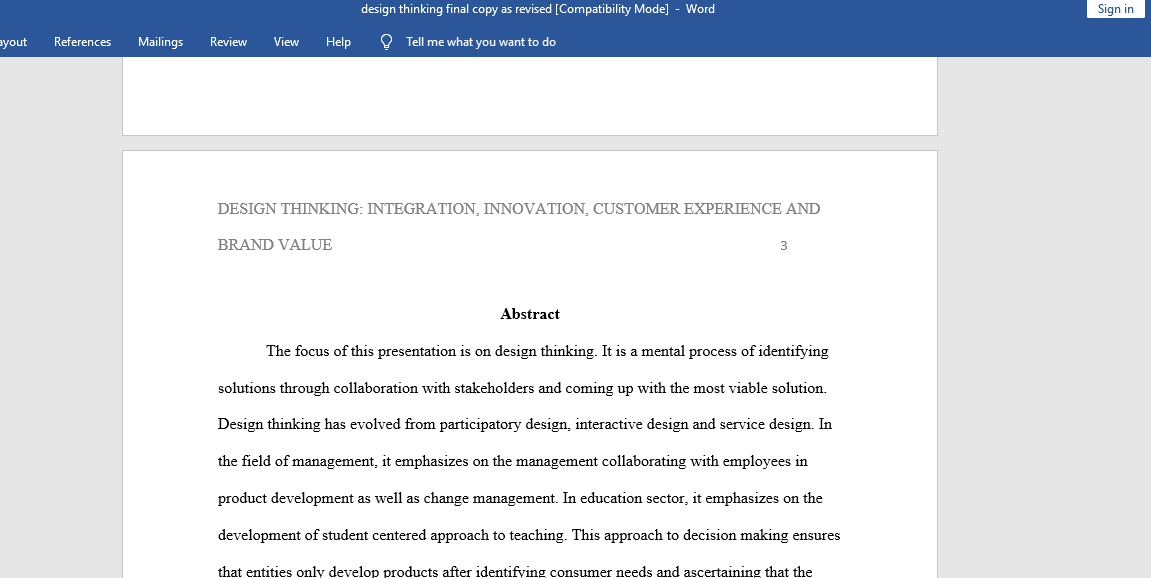Design Thinking: Integrating Innovation, Customer Experience, and Brand Value
Design Thinking: Integrating Innovation, Customer Experience, and Brand Value
I. Introduction
Topic, context, rationale, and thesis.
II. History and early evolution of design thinking
A. How design came to be
B. What design has become
III. Design thinking in product development
A. Why use design thinking for development?
B. What are the benefits
C. What are the negatives
IV. Design thinking in other applications
A. Teaching with design thinking
B. Managing with design thinking
C. Environmental, green design
V. Future of design thinking
A. What design can become
B. Where can design thinking take us?
VI. Conclusion
Topic, thesis, context, main points
Design thinking: integration, innovation, customer experience and brand value
I. Introduction
Design thinking is a very important concept that is used in theory and practice. In modern societies and organizations, design thinking has been viewed as one of the key panaceas to challenges facing them as well as a key source of capabilities necessary for exploiting emerging capabilities. Design has been employed in various fields in providing new products and services. It has been successfully employed in boosting the customer experience and enhancing the brand value. In contemporary organizations, the workforce is faced with challenges that require the designing of innovative solutions. It involves the need to inquire into problems, creation of contextualized knowledge regarding the problem at hand and the development of plausible solutions as well as competencies. Design thinking mainly refers to the mental process that individuals goes through when truy9ing to solve the challenges they face. It is evident that design thinking has proved to be a major solution to the problems faced by individuals and organizations as compared to the conventionally used systematic problem solving processes. In this study, the various merits and demerits of design thinking are explored.
Application of design thinking in diverse disciplines is also explored including the future of design thinking.
Thesis statement
Design thinking is applicable in utterly all fields in development of solutions as opposed to the traditional approaches to solving problems.
Topic, context, rationale, and thesis.
II. History and early evolution of design thinking
A. How design came to be In early days, participatory methodology was mainly evident in urban planning. As early as 1960s, participatory design had gained a lot of prominence. It involved the integration of the end users in the development phases of products and projects. As the participatory design progressed in 1980s, it becomes synonymous with interactive design. Many of its concepts were borrowed from the field of science, which included usability testing and prototyping. Later on role playing was also incorporated in design thinking. During this phase, it is evident that participatory design had a number of pitfalls. It completely ignored user experience. It ignored the perspective of the user in the design process. These challenges led to the development of user centered design by Donald Norman. The focus in design shifted from usability to meeting the interests of the end users. According to Norman, user control as well as humanized participatory approach was key to coming up with the right design. It involved making the design process more visible. It implied that users could now have control not only on the use of the end product, but also in the design process. The two design approaches are summarized below
A few years later, service design emerged. The participatory design, user centered design as well as the need to meet customer interests and experiences have informed service design. Service design thus draws from diverse sources including traditions, the products and the environments in which they are used the customer experiences as well as the interaction design. This definition of service design is summarized below
B. What design has become Later, a new approach to design emerged. There was a need for holistic mind set in design.
Enzio-Manzini came up with META-Design. Instead of focusing on the end users, service design was enhanced to focus on all users of the service focusing on the development of relationships with the stakeholders and opening up communication in the development of value. Design moved from a mere set of tools to a clear mindset. These developments has led to the evolution of design to its current status
Answer preview for Design Thinking: Integrating Innovation, Customer Experience, and Brand Value
Access the full answer containing 12 pages by clicking the below purchase button

